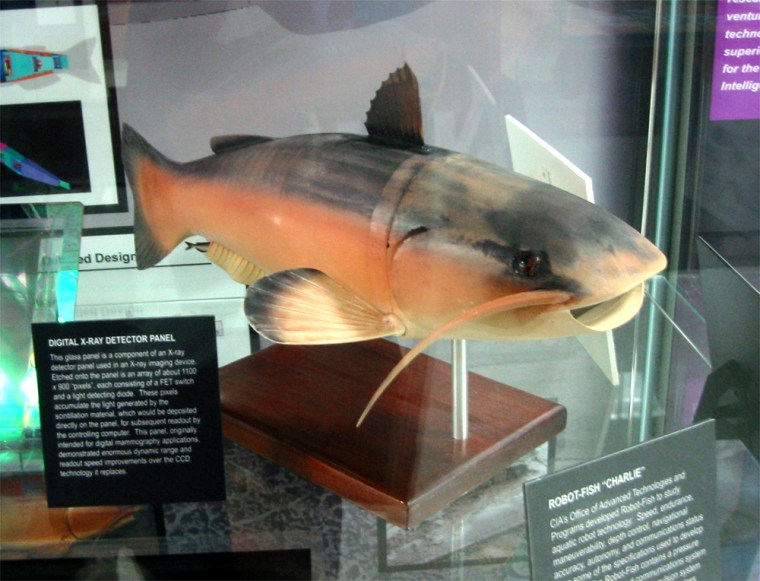When the CIA’s secret gadget-makers invented a listening device for the Asian jungles, they disguised it so the enemy wouldn’t pick it up and examine it: The device looked like tiger droppings.
The clever guise worked. Who would touch such a thing? The fist-sized, brown transmitter detected troop movements along the trails during fighting in Vietnam, another quiet success for a little-known group of agency researchers.
Into the open
The CIA’s Directorate of Science and Technology is celebrating its 40th anniversary by revealing a few dozen of its secrets for a new museum inside its headquarters near Washington. Accessible only to CIA employees and guests, it is the “finest spy museum you’ll never see,” said Keith Melton, a leading intelligence historian.
Exhibits include the jungle transmitter, a robotic catfish, a remote-controlled dragonfly and a small camera strapped to the chests of pigeons and released over enemy targets as recently as the 1970s. The secret gadgets currently used by CIA are left to the imagination of visitors.
The pigeon missions remain classified, made possible only after the CIA secretly developed a camera weighing only as much as a few coins. An earlier test with a heavier camera in the skies over Washington failed after two days when the overburdened pigeon was forced to walk home.
“People don’t think of a pigeon as being anything more than a rodent on top of a building,” said Pat Avery of Newalla, Okla., who runs the National Pigeon Association and recounts exploits decades ago by famous military pigeons such as “Spike” and “Big Tom.”
But as surveillance technology improved, the need for CIA pigeons diminished. “They’re pretty passe now,” she said.
Agency lore holds that a so-called “High Standard” pistol on display was so quiet that William “Wild Bill” Donovan, founder of the agency that became the CIA, pulled the trigger inside the White House to demonstrate for Franklin D. Roosevelt, who never heard a shot. The .22-caliber was standard issue among CIA employees for years.
“The president was on the phone at the time, so Donovan proceeded to fire the entire magazine, 10 rounds, into the bag of sand in the Oval Office then placed the smoking-hot weapon on the desk and told him what he had done,” said Toni Hiley, the curator for the CIA museum. “We can’t even imagine that sort of thing happening today.”
A robot catfish called 'Charlie'
In 2000, the CIA built a catfish it calls “Charlie,” a remarkably realistic swimming robot. The spy agency still won’t disclose much about its mission, but experts speculated it collects water samples near suspected chemical or nuclear plants.
One outside scientist consulted by The Associated Press said the catfish robot was so realistic — except for pectoral fins made slightly too large — that it might be eaten by predators while on its cloak-and-dagger missions. The AP obtained a videotape from the CIA of the catfish swimming during one test.
“A lot of things in the wild like to eat those,” said Jimmy Avery, an aquaculture professor at Mississippi State University. He said Charlie was apparently made to resemble a channel catfish commonly found in rivers worldwide. “When you look at it from above, it would be difficult to pick that out from any kind of real catfish.”
The CIA isn’t showing off just its successes. It invented a remote-controlled dragonfly for delivering tiny listening devices outside windows: a bug carrying a bug. But the so-called “insectothopter,” with a miniature engine built by a watchmaker, couldn’t fly straight in winds and didn’t work out.
The Science and Technology Directorate is among the CIA’s largest units. It was held in highest esteem for more than a dozen years until 1976, coinciding with the end of the Cold War, but experts say its internal influence with the CIA director has declined since.
“They’ve been very clever; they have not stuck to simply what would be the traditional and obvious means of intelligence collection,” said Jeffrey T. Richelson, who wrote a book about the directorate in 2001. “If they’re being successful, they’ll probably have devices more clever and harder to detect than in the past.”
